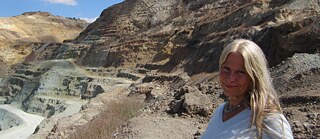Memories
Angela B. Clement

Copper Connects and Cures
I carried my copper work, the "Flying Mountain", which had already travelled in variations to museums and to the Goethe-Institut Athens, out of the plane in May 2015 with a suitcase. This happy landing precisely on the famous copper island of Cyprus had been agreed to first by Björn Luley and then by the subsequent director of the institute, Dr Christiane Krämer-Hus-Hus.
Your house, with its brightly coloured coat of paint immediately had a special glow for me. Even today, it opens into a Mediterranean garden with its blossoms and fruits, where cats roam and bright lizards scurry and visitors relax at their meetings. Wonderfully clever perseverance was what sustained the Institute during the most difficult times of the past. If the current, ambitiously wide-ranging programme continues to so invite the alert creative minds of Cyprus to dialogue, then the Goethe-Institut will shine very brightly into the future!
Warm hospitality, wonderfully affirmative interest and the many spontaneous practical supports at that time made our project "Copper Connects..." come alive right away. We were able to install the "Flying Mountain" on a long wall. It consists of 49 canvas ribbons soaked in earth and formed on the body of a cello, which swing up in the shape of a bird migration. The top and bottom of the wings bear colourful copper minerals from all continents. A large number of participants from the language courses at the Goethe-Institut visited the exhibition with their course leaders to work with me in short workshops. They cheerfully arranged copper solar wires with rock samples from the Troulloi mine and earth which I had collected on the island in the meantime, on canvases according to their ideas and supplemented them with bilingual sentences on copper properties. A nice surprise in the middle of all this was that the then CEO of the rich-in-tradition Skouriotissa mine, Constantinos Xydas, accepted the invitation of the head of the institute to visit us and kindly answer our questions. He immediately agreed that now the "Flying Mountain" will also carry finest samples of the ancient copper slags from Skouriotissa.
I got inspiration for my copper objects, which were created for and on Cyprus, on the hikes, the long search for traces of copper. I owe impulses for the work to my visits to the good events of the Institute for Interdisciplinary Cyprus Studies of the University of Münster on topics of politics, archaeology and geology. In 2016, my artistic works on the copper treasures of Cyprus became part of an exhibition in the Archaeological Museum of the university on the occasion of the 20th anniversary of this institute. Subsequently, I was invited to a Future Matters event at Cardiff University in Wales with the Cypriot copper theme. The copper works exhibited in the large rooms of the IASS Potsdam 2018/19 met with an enthusiastic response. During my work as a Fellow at the Institute, I was able to distribute copper and earth in workshops for the dedicated scientists there again – after the experiences at the Goethe-Institut.
„..Copper Cures“ My exhibition at the Goethe-Institut Cyprus featured the `Cataplasm of Galenos`, square works with linen cloth and blue-green copper minerals. Because of the excellent antimicrobial effect of copper on skin wounds and eye complaints, the Greek doctor Galenos travelled to the island as early as around 166 AD. He then obtained large quantities of the healing Cypriot copper salts himself from the depths of the mines there. Right now in December 2021, at an altitude of 400 km on the ISS in space, German astronaut Matthias Maurer is testing newly structured antimicrobial copper metals with lasers. Applied on Earth, they could inhibit the growth of dangerous germs in hospitals and public spaces.